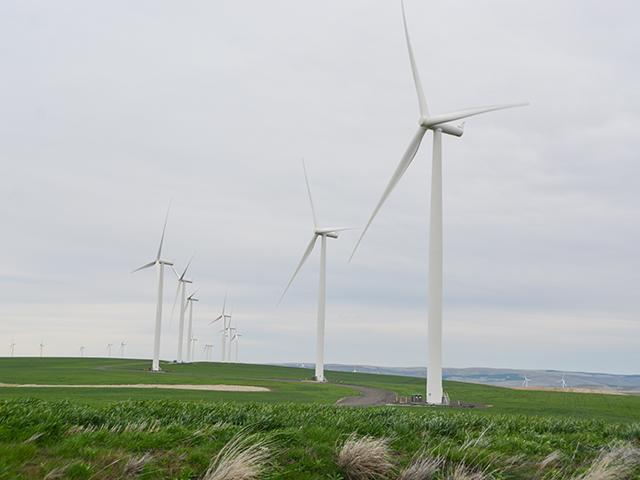USDA Rolls Out Rural Electric Funds
Touting Biggest Rural Power Investment Since FDR, USDA Details Rural Clean Energy Dollars
OMAHA (DTN) -- USDA on Tuesday will roll out $10.7 billion in clean-energy grants and loans for rural electric providers that the Biden administration is declaring as the "single largest investment in rural electrification" since the 1936 Rural Electrification Act.
Using funding from the Inflation Reduction Act, USDA will lay out two new loan and grant programs for rural electric cooperatives and other rural power providers.
The two funding programs include:
Empowering Rural America Program (ERA) provides $9.7 billion to build out renewable energy programs, zero-emission projects and carbon capture. This program will be exclusively for rural electric cooperatives.
A smaller program, Powering Affordable Clean Energy (PACE), provides $1 billion that could be used for partially forgivable loans to renewable energy developers and electric power producers such as cooperatives, as well as municipalities and investor-owned utilities. Those funds can be used for large-scale solar, wind, geothermal, biomass and hydropower projects as well as energy storage. Overall, USDA could expand its lending under PACE to as high as $2.7 billion.
For the Biden administration, these loans and grants will help convert more energy to meet President Joe Biden's goal for the country to lower emissions. He has set a goal for the country to have 100% clean electricity by 2035. The USDA rural funding comes on the heels of EPA announcing last week that it will require coal and natural gas power plants to lower their emissions.
MAKE MORE RESILIENT
On a press call Monday, John Podesta, a senior advisor to Biden for clean energy, said the overall effect of the two programs and funding is to help expand clean energy and make rural electric systems more resilient.
P[L1] D[0x0] M[300x250] OOP[F] ADUNIT[] T[]
"It'll invest in the local economy and our nation's rural co-ops, which have powered rural America for nearly a century, and it will make families healthier by cutting harmful pollution," Podesta said. "And because clean energy is increasingly cheap energy, it will help families and farmers and small businesses across rural America save money."
On the ERA, Agriculture Secretary Tom Vilsack said the Inflation Reduction Act allows "stacking" of benefits along with loans and grants, so the cooperatives would be able to take advantage of production tax credits or investment tax credits as well. There will be grants of up to 25%, as well as loan modifications and refinance options. Letters of interest from different rural cooperatives will run for a short period from July 31 to Aug. 31 of this year.
Under PACE, those projects could be available for loan forgiveness running from 20% to 60% of the total projects. USDA will be accepting letters of interest from groups on PACE from June 30 to Sept. 29 of this year.
COMPARING TO THE PAST
Asked about the comparisons to rural electrification in the 1930s and 1940s, Vilsack said the process will allow rural electric cooperatives (RECs) "to reach parity" with privately-owned investor utilities that already have extensive renewable energy portfolios.
"This is not expected to be the be-all and end-all from a standpoint of solving every REC's challenges across the country, but it is a significant investment that is going to allow a number of RECs to accelerate their plans," Vilsack said. He added, "This obviously is not going to be done in a year or two. It's going to take time, but this is a pretty significant start."
Vilsack added the investments from the projects will create more jobs in rural areas.
Ali Zaidi, a climate advisor to the president, said the projects developed from these USDA programs will tie into new manufacturing projects cropping up. He pointed to a new solar panel manufacturer opening up in Pennsylvania as one of those projects. Zaidi also tied the renewable energy projects with the expansion of charging stations for electric vehicles in rural America.
Zaidi said rural communities will be able to market themselves for their investment in clean energy.
"We know that capital formation, especially in rural communities, is harder and it's harder to attract financing and investment. This allows more of those rural communities to tap into the opportunity," he said.
Asked about carbon capture for smaller rural projects, Vilsack said, "We want to make sure that we are investing in and supporting all strategies that can help advance a clean economy." He pointed to the flexibility of loans and grants that can be tied into different tax credits and stacked. "You can put a package together with the investment tax credits and so forth, where you can pencil it out and where it makes economic sense as well as environmental sense."
Chris Clayton can be reached at Chris.Clayton@dtn.com
Follow him on Twitter @ChrisClaytonDTN
(c) Copyright 2023 DTN, LLC. All rights reserved.




